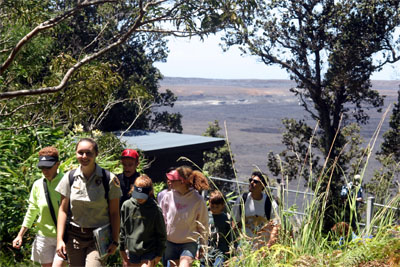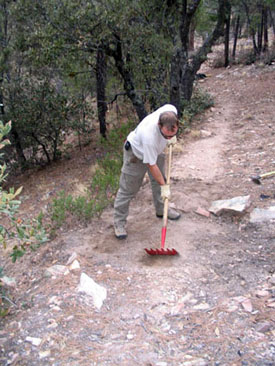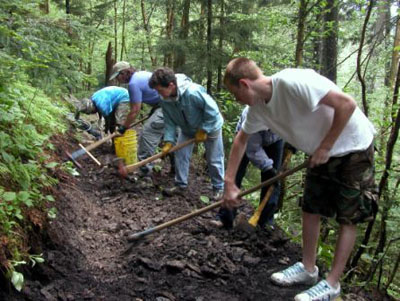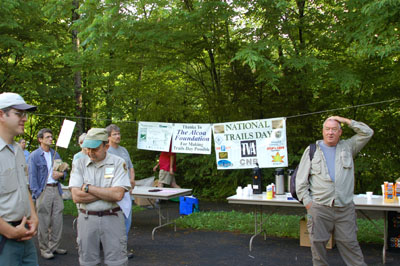
Volunteers make major contributions
Home to many intriguing shipwrecks, the Pacific waters abutting coastal California’s Channel Islands National Park are a haven for archaeologists.
Despite the specialized nature of their work, these archaeologists do not examine the sunken vessels as park service staff members. They do the skilled, high-risk work as volunteers.
“We have competent, high-quality volunteers,” Yvonne Menard, public information officer at Channel Islands National Park, said. “People who have skills and abilities at the professional level come and contribute.”
 |
Volunteer Sara Abraham leads a hike on the rim of Kilauea Volcano in Hawai’i Volcanoes National Park (Photo courtesy of National Park Service). |
Experts deployed on research missions are not the only volunteers at Channel Islands National Park, though. The park also enlists high school students to remove alien plants.
No matter the nature of the duties assigned to volunteers or the location of the park, volunteerism is a common denominator among national parks.
At Hawai’i Volcanoes National Park on the Big Island of Hawai’i, 247 of the 832 park employees are volunteers, Park Ranger Mardie Lane said. The park’s volunteers have a wide range of responsibilities.
“They monitor the nesting turtles,” Lane said. “They monitor the nesting of the endangered Hawaiian Goose, the ‘Nene.’ They hike the backcountry, surveying trails and helping hikers. And they work at the visitors center.”
Volunteerism is equally important at Mammoth Cave National Park. In 2005, 510 people volunteered a total of approximately 31,000 hours at the Kentucky park, public information officer Vickie Carson said.
“We’ve had good luck,” Carson said.
A volunteer maintains a trail in Saguaro National Park (Photo courtesy of Friends of Saguaro National Park). |
 |
Mammoth Cave National Park’s volunteers perform many significant tasks such as building and patrolling trails, exploring and mapping caves, staffing the information desk and helping in the campground.
Volunteers have long played integral roles in national parks.
“We opened our doors in 1980 with volunteers working alongside rangers,” Menard said.
Menard said that four of Channel Islands National Park’s original 12 volunteers worked there for more than 20 years.
“We have a real history of a volunteer program here,” Menard said.
On that score, Channel Islands National Park is not alone.
Target, the department store, has supplied Mammoth Cave National Park with volunteers for approximately 15 years, Carson said.
Boy Scouts of America and the Sierra Club are two other organizations that have historically provided volunteers for Mammoth Cave National Park.
“Some of these relationships are so old I don’t know how they started!” Carson said.
The type of organizations Carson mentioned is not the only type that directs volunteers to national parks. Friends of Saguaro National Park and Friends of Great Smoky Mountains National Park both help to staff their parks with volunteers.
 |
Volunteers work on the Appalachian Trail in Great Smoky Mountains National Park (Photo courtesy of Friends of Great Smoky Mountains National Park). |
Friends of Saguaro National Park annually stocks the Southern Arizona park with between 150 and 200 volunteers who contribute approximately 30,000 hours, Executive Director Bob Newtson said. Considering the rate at which the National Park Service values volunteer work, Newtson said, those 30,000 hours equate to roughly $500,000 of service annually.
Newtson culls many volunteers from retirees and nearby University of Arizona students, two predominant groups in the area around Tucson and the park.
The Friends of Saguaro National Park volunteers help with wildlife research programs. For instance, adults and high school students use radio telemetry to track desert tortoises. “Interpretive” volunteers also lead educational hikes in the park.
Saguaro National Park is located approximately 10 minutes by automobile from downtown Tucson. Such proximity to a metropolitan area has its drawbacks, but the slice of preserved nature benefits from the large pool of prospective volunteers Tucson provides.
“Many of the volunteers are out there a couple times a week,” Newtson said.
Friends of Great Smoky Mountains National Park recruits volunteers for the park, which is located along the border between Tennessee and North Carolina. The park’s most heavily trafficked areas, such as Elkmont, make great use of volunteers.
“They can’t obviously afford to have every law enforcement ranger of the park stationed at Elkmont,” Burcham said. “Sometimes they need a little extra help, so we will send out an appeal to our volunteer pool and recruit volunteers.”
Burcham said that volunteers help park staff prevent visitors from approaching elk and other wildlife for a close-up photograph.
“Volunteers are trained to assist visitors in understanding how to properly behave when they’re looking at elk herd,” Burcham said.
| Volunteers assemble at Sugarlands Visitors Center (Photo courtesy of Friends of Great Smoky Mountains National Park). |  |
Active recruitment of volunteers is not always necessary. Many people approach national parks unsolicited to volunteer their time.
“We get quite a few emails through our website,” Burcham said.
Wind Cave National Park in South Dakota uses volunteers as “campground hosts” in June, July and August. In exchange for a campsite, the volunteers perform minor maintenance work and secretarial duties, in addition to checking that all groups using a campsite are registered.
Prospective volunteers frequently approach the park to offer their service.
“People come and say, ‘Hey, I might be interested in staying in your campground,’” Park Ranger Mike Laycock said.
Some of the park’s volunteers have been donating their time for 10 years, Laycock said.
Friends of Saguaro National Park is also frequently approached by people interested in volunteering. They receive several inquiries each week, Newtson said.
“We recruit as part of our mission, but a lot of people also contact us,” Newtson said.
At Channel Islands National Park, visitors often offer to volunteer after they explore the park, Menard said. She said that 676 volunteers donated a total of 54,660 hours to the park last year, representing the equivalent of 26 full-time jobs.
Although volunteer labor saves parks large sums of money, Menard said that parks value volunteer contributions for other reasons. By volunteering, people in the community around a national park not only help the park, but also feel invested in it.
“It’s not about saving money. Volunteers don’t supplement pay jobs, they come in and do work we wouldn’t be getting done otherwise,” Menard said. “Volunteerism is a great way to connect the park to the community.”
The Top 6 National Parks for Volunteers
- Yosemite National Park, California – 3,905 persons
- Yellowstone National Park, Wyoming / Montana / Idaho – 2,502
- Great Smoky Mountains National Park, North Carolina / Tennessee – 2,318
- Rocky Mountain National Park, Colorado – 2,070
- Glacier National Park, Montana – 1,801
- Olympic National Park, Washington – 1,427
Source: National Park Service Office of Communications.

Comments are Closed